
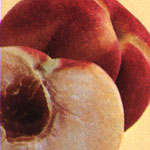
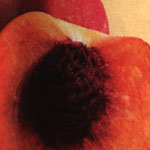
Fairtime Fay Elberta Flavorcrest

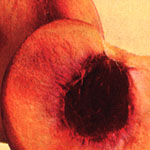

June Lady O'Henry Redhaven
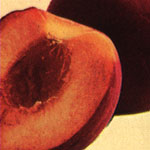
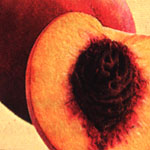
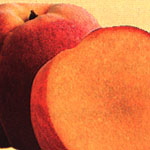
Rio Oso Gem Yakima Hale
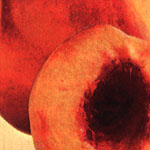
FoodFood InformationFruitDeciduous
Peaches date back to ancient China. They are drupes and are related to
plums, nectarines, apricots, and almonds. They arrived in North America
via Europe and the Middle East.
Our domestic peach season is from May to October. During the winter and
early spring months, from December to April, a limited supply of peaches
are brought in from Chile. Unlike other Chilean fruit, such as grapes which
are very good, nectarines which are good, and plums which are fairly good,
usually these imported peaches are not very tasty. Peaches are grown in
most states, but California and the South are the largest growing areas.
Peaches are also grown commercially on a large scale in New Jersey, Pennsylvania,
Michigan, Indiana, and Washington State. For the most part, the peaches
produced east of the Mississippi aren't quite as large as those grown in
California, but the eastern fruit is usually more juicy. The hundreds of
varieties of peaches can be divided into two groups: the clingstones, also
known as clings, and the freestones. In the freestone group are some varieties
that aren't totally free and these are called semifrees. There is a great
difference in the flavor, texture, and succulence of clingstone and freestone
peaches. Ninety-nine percent of the cling peaches are grown in California
and sold to canners who put up tinned peaches and fruit cocktail; nearly
all the freestone peaches are sold as fresh fruit.
If you have ever bitten into a fresh California cling peach, you'll understand
why they are sold to the canners. They are hard, rubbery, and not very juicy.
But cooking them in sugar syrup changes the undesirable texture and makes
them quite palatable. Some people object to the oil like texture of the
sugar syrup in canned cling peaches, a thickness of the liquid caused by
the high natural pectin content of cling peaches. You can avoid this by
purchasing tinned freestones, which do not have nearly as much pectin. In
Italy, cling peaches put up in wine are a great delicacy. In the fall, a
small amount of California cling peaches are shipped to market and sold
in predominantly Italian neighborhoods for similar preparations.
Peaches come in two flesh colors: yellow and white. Not too long ago, about
half the peaches were white-fleshed, but, like the white nectarine, the
white peach has been replaced by the newer golden-fleshed varieties. Back
when we had lots of trolley cars but no jet planes, there were many fine
varieties of white peaches. The older, white varieties-Georgia Belles,
Carolina Belles, Dixie Belles, and especially Hiley Belles-were
the belles of the peach ball. What they lacked in color they more than made
up with a distinctive tart-sweet flavor. They were much juicier than the
yellow-fleshed varieties and had a more delicate texture. To many old-timers,
the Belles may be gone, but they are not forgotten. A limited supply of
a new white variety that is almost all red in skin is now being shipped
to market. These command premium prices even though they are very fragile
and easily bruised.
Today, as with nectarines and plums, there are countless new and improved
varieties of peaches, and all of them are superior to the yellow fruit we
had in the good old days. The varieties are too numerous to list and most
of them are too close in appearance to call.
When comparing peaches of yesteryear to those of today, the most noticeable
difference is in the skin texture. Peaches of yore were as fuzzy as kiwi
fruit. Today's peaches are as slick as a baby's bottom. Peach fuzz could
not be rinsed off under the cold-water tap. lt either had to be removed
by peeling the fruit or it could be rubbed off with a damp cloth. People
with sensitive skin would break out in a rash if they went near a peach.
What happened to the fuzz? Do we now grow fuzzless varieties? No, today's
peach is just as furry and fuzzy as the peach of yesteryear, but the fuzz
is removed by mechanical brushing at the orchards prior to packaging and
shipping.
The trick to selecting fine peaches is to look for firm, colorful, not bruised
fruit. If they are too green in color (called ground color in the produce
trade), they may shrink, shrivel up, and not ripen properly. Allow firm
peaches a couple of days at room temperature to ripen properly. If you buy
ready to eat peaches, especially in a self-service market, they may be bruised.
Very small peaches should be avoided because they may have been picked prior
to reaching maturity. The medium-sized peaches are every bit as flavorful
as the larger and usually more costly fruit. The first peaches to arrive
in spring are usually of below-par quality. They are undersized and overpriced.
It is usually a good idea to wait until the month of June to start buying
peaches and to stop in mid-September. By that time the fruit is coming out
of storage, prices are higher than in mid-season, and the quality has started
to slip. However, from June 15 to September 15-enjoy.










WHEN TO BUY: At peak June, July, and August
WHAT TO LOOK FOR: Firm, colorful, not bruised fruit
HOW TO STORE: Ripen at room temperature; refrigerate when ready to eat
Deamer 5/97